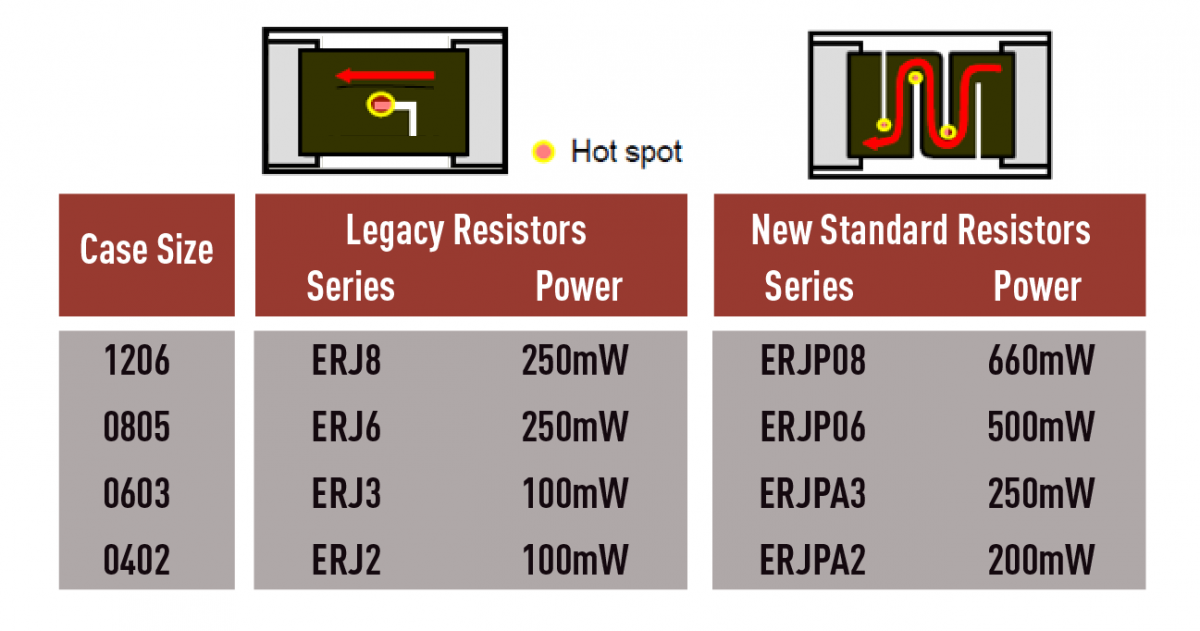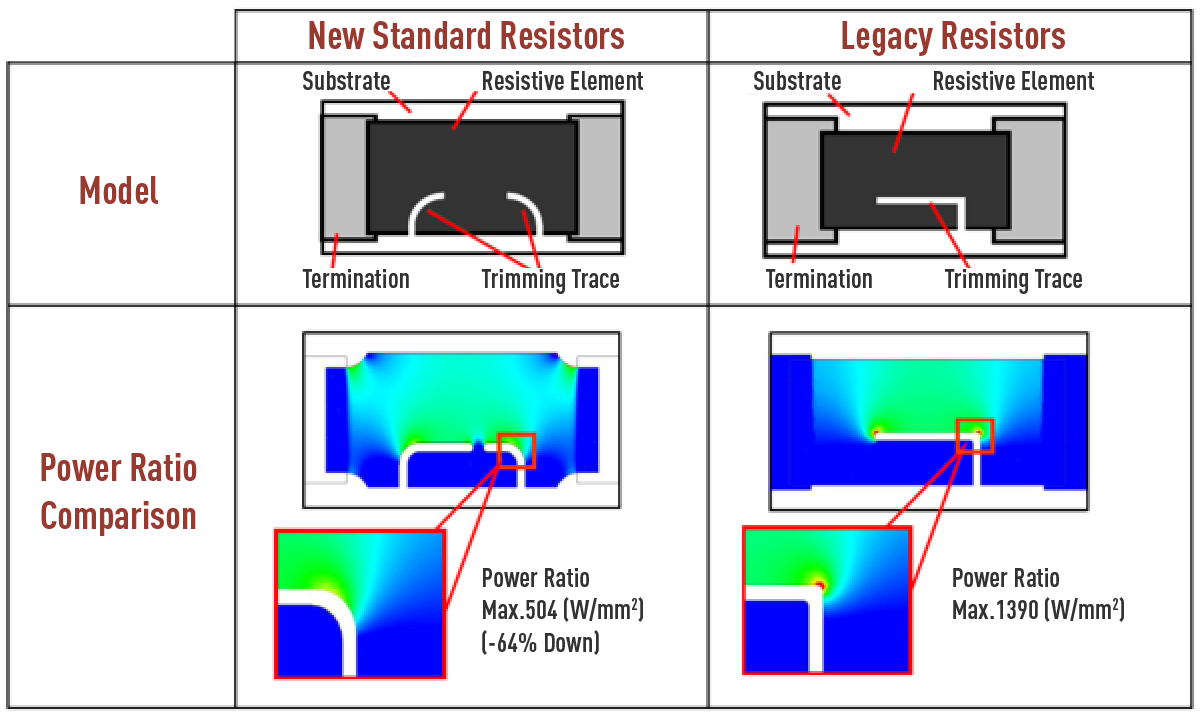Set Higher Standards for Resistors

Resistors are arguably one of the most fundamental electronic components and are key for every single electronic circuit in existence. Some Resistors are found as old-fashioned wire-wound parts soldered onto PCBs by hand, while others are integrated into ICs directly in the form of polysilicon traces.
In this article, we will look at the importance of Resistors in modern electronic design and how the latest Panasonic range of Resistors can help engineers reduce the cost of their products while making them more efficient.
Resistors in History
One of the oldest mass-produced Resistors is the carbon composition Resistor. It consists of a cylinder made of a carbon/ceramic power mix, which is bonded with a resin and a pair of metal caps with component legs attached to either end. While these Resistors were useful for early electronics (such as amplifiers and radios), they quickly became problematic for a multitude of reasons.
Needless to say, it did not take long for the industry to develop a wide range of Resistor types, with all having their own advantages as disadvantages. Wire-wound Resistors find themselves in power applications in which a standard carbon Resistor would vaporize, while some metal film Resistors have proven incredibly popular in precision circuitry, which requires resistance tolerances of less than 1%.
The Resistor market today is one that would dazzle even the most experienced engineer—parts coming in all different shapes and sizes, all for use in specific applications. To make matters more complex, technology is ever changing, with a rapidly growing interest in IoT technologies and solutions that are requiring continuously reduced circuit sizes. And that’s not to mention wearable electronics that would require flexible circuits and power circuitry that needs to handle more power in smaller spaces.
A New Standard Line of Resistors from Panasonic
Panasonic not only recognizes the importance of Resistors but is releasing a new line of Resistors to help engineers produce cheaper, smaller and more efficient designs. The older line of Resistors (ERJ line) has either been made smaller while handling more or the same amount of power or increased in power dissipation while still having the same footprint.
Taking a closer look, Panasonic was able to increase the power dissipation of surface mount Resistors courtesy of improved trimming technology. You see, standard SMD Resistors use straight lines in an L shape to trim the Resistor to the specified resistance. The problem here is that it winds up creating sharp corners of material which result in “hot-spots”. Despite the rest of the Resistor being able to handle more power, it is these hot-spots that cap the maximum power dissipation and also cap the maximum pulse current.

Panasonic’s new trimming technique uses curved lines from both sides of the Resistor. Doing this almost entirely removes the aforementioned hot-spots because of an overall 64% reduction in their power ratio. What’s more, this trimming technology also improves the pulse characteristics, allowing the ERJP series to typically handle double the power in the same case size.

The use of curved and meandering trims on the new line of Resistors has led to smaller parts being able to handle greater power. This has reduced their overall footprint and weight. For example, a product using 10,000 1206 standard SMD Resistors can use 0805 high power parts in their place and reduce the total weight by 40g (a 60% reduction) and use up to 50% less PCB space.
It’s also worth pointing out that Panasonic’s new line of Resistors come in several variations to serve many different applications. For example, the ERJUP6 is a 0.5W Resistor in a 0805 footprint with anti-sulfur and anti-surge capabilities while the ERJT06 is a 0.25W Resistor also in a 0805 footprint but is specialised for anti-pulse applications.
The new line of ERJP Resistors have tolerances as low as ±0.5%, are available in resistances ranging between 1Ω to 10MΩ, a TCR of ±100 ppm/°C, and a temperature range between -55°C to +155°C.
Implementation Examples of Using the New Line of Resistors
ERJPA2
The ERJPA2 is a 0402 SMD Resistor capable of dissipating 0.2 W of power and is a potential drop-in replacement for the older ERJ2 or can be used to replace the ERJ3 or ERJ6 if a smaller pad and higher power dissipation are desired.
ERJPA3
The ERJPA3 is a 0603 SMD Resistor that is capable of dissipating 0.25 W of power and is a potential drop-in replacement for the older ERJ3 or can be used to replace the ERJ6 if a smaller pad and higher power dissipation are desired.
ERJP03
The ERJP03 is a 0603 SMD Resistor that is capable of dissipating 0.2 W of power and is a potential drop-in replacement for the older ERJ3 or can be used to replace the ERJ6 if a smaller pad and higher power dissipation are desired.
ERJP06
The ERJP06 is a 0805 SMD Resistor capable of dissipating 0.5 W of power and is a potential drop-in replacement for the older ERJ6 or can be used to replace the ERJ8 if a smaller pad and higher power dissipation are desired.
ERJP08
The ERJP08 is a 1206 SMD Resistor capable of dissipating 0.66 W of power and is a potential drop-in replacement for the older ERJ8 or can be used to replace the ERJ14 if a smaller pad and higher power dissipation are desired.
It can be seen that the new line of Resistors not only reduces the size of the Resistor for the same power but can also increase power capability. But how does reduced Resistor size and higher power dissipation help designers, and what can an engineer expect when using the new Panasonic line of Resistors?
The Benefits of Smaller, More Powerful Resistors
Using parts that are smaller and able to handle more power has many advantages, some not being entirely obvious at first.
First, Resistors such as the ERJP03 not only act as a potential drop-in replacement for the older ERJ3 (i.e., no need for footprint changes on older PCB designs), but they can handle more power and, therefore, can be used to either replace larger Resistors or combine multiple small Resistors used in parallel to improve power dissipation. The reduction in part count can help to reduce BOM costs and, therefore, the cost of the overall manufacturing process.
Replacing older Resistors (e.g. ERJ8) with smaller Resistors (e.g. ERJP06) with either the same or greater power dissipation can have a dramatic effect on the overall design of a PCB. The use of smaller components helps to save previous PCB retail space, which drives down the cost of PCBs. The saved space also helps to reduce the overall size of the circuit, which has a number of benefits. For one, smaller circuits often have smaller trace lengths, which can be highly beneficial in environments in which EMC may be a concern. Second, smaller circuits are more portable and easier to integrate into tight environments such as wearable electronics. If smaller components are used but the PCB size is kept the same, then the designer has the opportunity to integrate more functionality into their product and, therefore, improve the capabilities of the end product.
Combining the use of smaller and fewer parts also has an effect on the manufacturing aspect. Having fewer components to place in a smaller space allows for more PCBs to fit onto a single panel and reduces the time for pick-and-place machines to populate the PCB. Having fewer solder joints also reduces the number of potential failure points both during manufacture and when in service. The use of fewer solder joints also helps to reduce time required for automatic optical inspection (AOI) or can allow for more components to be inspected in the same amount of time.
Conclusion
Choosing the right Resistor for your design is an important task, and with so many Resistors available, it can be truly daunting. Panasonic not only recognizes the importance of Resistors but is ever pushing the boundaries of technology to produce Resistors that are smaller and more efficient.
If you need help integrating Resistor technology into your designs, then please visit Panasonic’s contact page.
